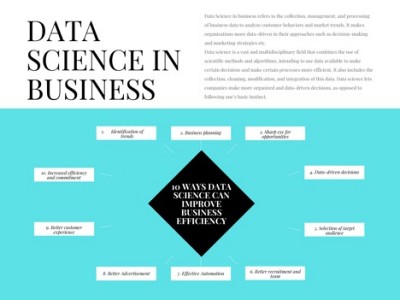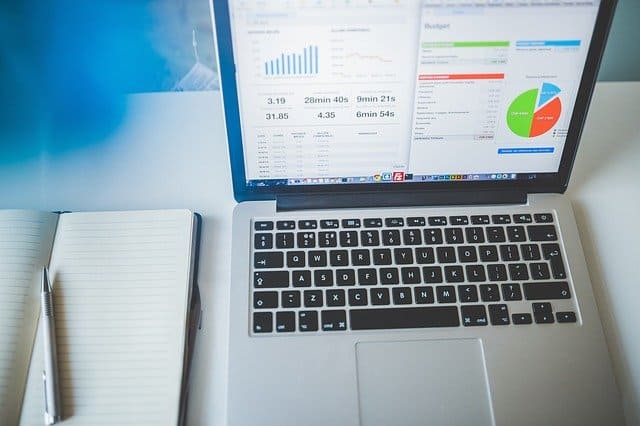Have you ever wondered if you can utilize your organization’s past performance and data in gaining insights and predicting future outcomes? Well, that is possible. Simply, by using some analytical skills, technologies, and statistical practices.
Data analytics has attracted the attention of many organizations in the corporate sector. Analytics is often regarded as the science of analysis automated by various intelligent statistical procedures and machine learning algorithms.
The advent of analytics has brought a dynamic industrial transformation in which risks and loss frequencies can now be identified and corrected. Because it translates all types of data into insightful and pertinent information, analytics can impact a variety of disciplines and sectors. Recently, different types of firms and businesses have started relying more on providing their statistics and data to data analytics to analyze their performance and then relate it to the market’s current trends.
Business analytics has proved to be very significant in assisting industries to improve their growth rate, which has led to increased investment in analytics. International Data Corporation (IDC) has revealed that banking, large-scale and small-scale manufacturing, and specialized services sectors are the top investors in Data analytics and Big Data fields for 2021.
The changes and advancements in technology have transformed many manual and traditional ways of analyzing and processing data into more intelligent and less tedious alternatives. In the same way, large companies in the corporate sector have moved their ways of analyzing data to business analytics and predicting any investment’s future outcomes based on past insights.
Conventionally, CEOs/CFO’s primarily relied on the past data and performance of the company to predict the future of any investment; however, now, the trends are evolving. Companies are increasingly more inclined towards data analysis technologies for identifying patterns in data such as machine learning, automated analytics, etc.
In this article, we will discuss the importance of business analytics in Finance and helping large companies with their analytical procedures. We will get to know how these analytics are helping large businesses in determining their risks for the future and implementing more profit-oriented strategies that will benefit them in the long run.
What is analytics in Finance?
Being a significant contributor in business communication and firm performance regulation, techniques of financial analytics have a substantial impact on all aspects of the business as it plays a vital role in forecasting future strategies for companies. Different business analytics approaches inspect a large amount of fiscal and appropriate data to distinguish other models and then make forecasts for the betterment of businesses.
Business analytics is defined as the formulation of improvised studies to help business analysts provide concrete solutions to a wide range of commercial and professional issues and predict the upcoming economic and fiscal situations.
The ultimate objective of analytics in business is to design the business schemes through a dependable and objective understanding of the situation instead of random ideas. Through careful analysis of any organization’s financial positions and statistics, tools used by financial analytics help the firms understand their current financial situation and optimize their future performance.
It guides companies about various aspects and changes that should be made to optimize the growth. The current market trends of financial analytics are motivating more and more organizations to share their relevant data for making the best possible decisions according to their set goals. Such analytics approaches help businesses understand the importance of revenues, gross sales, net income and then calculate and handle their resources and predict discrepancies within firms and markets where they compete.

How Business Analytics works in Finance
Financial analytics provides understanding about companies’ monetary condition and increases the productivity resources of the company. Moreover, it facilitates businesses to develop income declarations and business practices. When applied appropriately, Business Analytics can accurately forecast future events involving consumer behavior market trends and create more efficient strategies to increase profitability.
The future of business analytics has become more precise with the emergence of the latest technologies such as machine learning, Artificial Intelligence, and data analytics. They allow the organizations to gain insightful information by analyzing large datasets and ultimately help understand the customer’s needs. Moreover, data visualization techniques will enable us to display the insights in a meaningful way to make them easy to understand for everyone in the organization.
This section covers various aspects depicting how business analytics has transformed the corporate sector and increased the production rate.
1. Improved Decision Making:
Many large companies are often stuck when they are unsure which vendors for the business activities will generate the most revenue and enhance their efficiency. Analytics in business resolves this problem by providing insights on the vendors based on customers’ experience, the speed with which they deliver, and the quality of work they carry. This way, analytics help firms make critical decisions based on proper insights.
2. Enhanced Efficiency:
Business firms can take help from different resources to examine their performance and analyze the future outcomes of their investments. It helps uncover various business opportunities that are often overlooked. Repeated analysis helps strengthen the insights and enhance the performance.
3. Better Problem Solving:
Business processes are often subjected to such problems that require attention. And to solve those issues, the rest of the business activities are stopped, and it dramatically reduces the production rate and results in a significant loss. This is precisely where analytics comes into play. By using analytics in such business processes, analysts calculate the probability of the expected loss and inform before time. In this way, such problems can be timely resolved in a better way.
4. Improved Customer Services:
Customers are lucky in that respect with the wide range of options provided. Firms use analytics to ensure that their customer relationship is retained. This enhances the customer’s relationship with the firms and strengthens their trust. Let’s suppose the case of amazon, a famous online shopping website. The finance department can analyze the customers’ activity on their website.
Based on their purchase history and select items, they can identify the patterns in the preferences of a specific customer. In this way, they can enhance the services of their customers by simply displaying their preferred items in the first place. This will create satisfied customers and ensure their loyalty to the firm.
5. Cut Down Turnover Rate:
The turnover rate refers to the percentage of employees that leave any firm over some time. In business, analytics help firms calculate the turnover rate and keep track of the problems of employees. In this way, the turnover rate can be significantly reduced. The HR department can utilize data and analytics to keep track of the performance of employees and identify if they are satisfied with their jobs. It also helps them check on the team members if they face any environmental problems.
Analytics will help HR professionals to get answers to these concerns. And with the insights obtained, they can identify how many employees would be likely to resign from the company. By hearing their problems and resolving them, the company can significantly reduce employee turnover.
6. Point Out Fraudulent Purchases:
Many organizations have begun to employ analytics in their businesses to tackle fraud. They achieve one method by analyzing previous consumer transactions and using data to identify possible fraudulent purchases. These businesses also use predictive analytics to analyze client profiles and evaluate the risk. This considers the threat posed by a specific customer and uses that information to reduce losses while also strengthening customer relationships.
7. Reduce Production Cost:
By using analytics, large companies can significantly reduce the cost required to manufacture products. Rather than spending resources on manufacturing different products, business firms can use analytics upon the collected data and make the production process more straightforward.
Consider the case of Intel. The tech firm used to conduct many tests to test the manufactured chips, but with the help of analytics on the data, the company significantly reduced the cost. The analytics now tell which type of chip requires which tests for validation and saves billions of Dollars.
8. Surging Marketing Strategies
Analytics in business is deployed because marketing and broadcasting are costly; therefore, dealers should have an idea about getting the maximum return on the amount invested. For this reason, systematic techniques like A/B and C split-testing are used. Social media pages, pop-ups, and product details are assessed and modified for online marketing to achieve the desired outcomes. Different products are arranged on the website are analyzed to describe the most appropriate place for maximum responses and profit.
9. Better product management:
When it comes to retail businesses, calculating the most suitable time for putting products for sale can be easily managed by data analytics. Retail companies identify the most widely used goods based on locality and time of the year. With this valuable data, companies can offer suitable goods at the most appropriate time, which ultimately helps increase sales.
10. SWOT Analysis
SWOT analysis refers to the process of identifying strengths, weaknesses, opportunities, and threats for your business. In simpler terms, analysis of an organization with its competitors. Large business firms have their competitor organizations, and they are always in the race to perform better than their competitors.
Analytics help the organizations conduct the complete analysis and get insights into where their company is lagging and the services where the competitors stand out in the market. You can overcome your weaknesses with those insights and improve the performance to make your business stand out from the contenders.
11. Risk Assessment:
One of the most critical purposes of implementing analytics in business is to analyze the risk associated with any activity or investment. Using predictive and statistical measures, the analytics measure the risks a company is likely to face. These risks are easily categorized because the analytics work upon intelligent algorithms.
Therefore, no matter which type of risk it is, the analytics deployed in business processes tend to find out the root cause of the problem and inform the organization before it has occurred. In this way, companies can make timely decisions to reduce the chances of loss significantly.
12. Keep track of upcoming market trends:
Another purpose of deploying analytics in business is to analyze the market trends and predict the ones that will stand in the future, even before other companies use them. In this way, your firm can stand out from its competitors.
The advent of AI influences nearly every channel, and predictive analytics has made it easy to navigate a risky investment and anticipate possibilities ahead of time. This allows businesses to profit from trends that other companies may not have foreseen, allowing them to stay ahead of the competition. Predictive analytics is also essential in identifying difficulties or financial setbacks, notably before losses are recognized.
-
How Bad Data influences Decision-Making

In our daily lives, we are constantly making tiny decisions, what to eat, what to wear, etc. Whether we realize it or not, all these decisions are based on data.
-
How Data Science Can Improve Business Efficiency – 10 Ways!

The hype for Data Science has been going around for quite a while now. Large organizations and businesses are jumping into this venture and are incorporating Data Science and Analytics
-
Data Analytics Vs. Business Analytics – Top 5 Differences

Big data is the talk of the town nowadays. Whether it’s a huge organization or a mere primary school, it’s hard to find a field where it doesn’t have an
The whole discussion can be summed up by saying that Analytics has paved the way for systematic enterprise solutions forecast that can provide foresight and guidance to firms when making high-risk decisions. But, especially in the digital age, one of the most effective areas where analytics impacts are the objective strategic practice; exposure to advanced analytics. Analytics also offers personalized strategic progress of a company because it can now track consumer behavior and communicate with them in a more direct and relevant way after identifying what they want or what financial objectives they desire.
Moreover, analytics can be regarded as the catchphrase of this era. Almost every business focuses on using it to alter how it makes decisions. There’s no doubt that business analytics has changed the nature of companies and the way they operate. Its significance cannot be underestimated, and with an increasing number of businesses relying on it for decision-making, it is something your company should consider incorporating if it hasn’t already.

